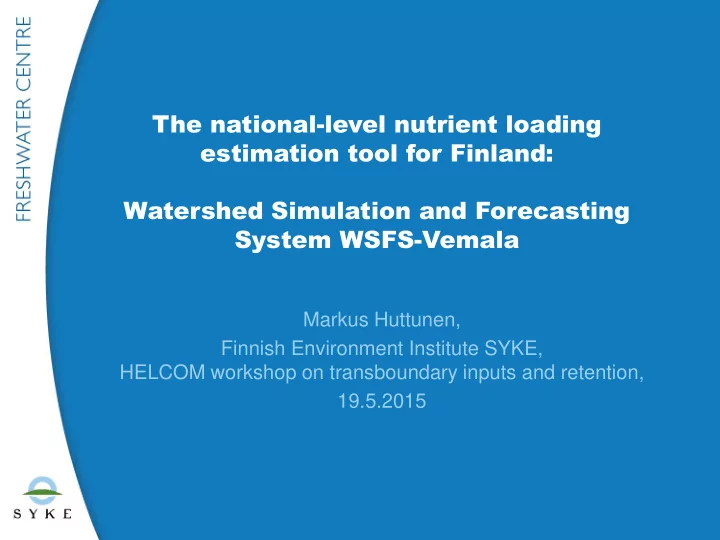

The national-level nutrient loading estimation tool for Finland: Watershed Simulation and Forecasting System WSFS-Vemala Markus Huttunen, Finnish Environment Institute SYKE, HELCOM workshop on transboundary inputs and retention, 19.5.2015
Basic structure of the WSFS-Vemala ● Hydrological SYKE-WSFS model: ○ Simulation of the hydrological cycle ○ Snow, soil moisture, ground water, runoff ○ Water transport in rivers and lakes ○ 1 day time step, semi distributed (6000 sub-basins) ○ Covers all Finland ● Nutrient loading model VEMALA: ○ Diffuse loading to rivers and lakes (agriculture, forest) ○ Point sources, scattered dwelling, atmospheric deposition ○ Nutrient transport and retention in rivers and lakes ○ Total phosphorus and nitrogen, suspended solids, TOC
Purpose of the WSFS-VEMALA ● Real time information of nutrient loading ○ Nutrient concentrations in rivers and lakes ○ Riverine loading to the Baltic Sea ○ Short term forecasts ● Scenarios ○ Climate change ○ Land use and farming practices ○ Changes in point sources, etc. ○ Co-effect of climate change and different actions: • In single lake • In river basin • In loading from Finland to the Baltic Sea ○ Support implementation of WFD and MSFD
Spatial & temporal resolution of WSFS-Vemala ● 1 day timestep. History since 1960. Scenarios until 2100. ● Covers all Finland + transboundary basins: ○ Tornio ○ Parts of Neva catchment flowing to Finland ● Field scale simulation of agriculture: ○ About 1 000 000 field parcels. 2 300 000 hectars. ● Simulation of 1 ha and larger lakes: ○ About 58 000 lakes in Finland ○ Relevant for retention simulation 4
Hydrological expertise in Finland Hydrological Modeling and Forecasting System (1/2) 5
Hydrological expertise in Finland National level nutrien load modeling (2/4) Structure of WSFS-Vemala water quality model 6
VEMALA V2-ICECREAM field scale simulation 19.5.2015 Tattari et.al., 2001
Catchment scale VEMALA-N processes Denitrification Plant 19.5.2015 Fertilizer uptake Organic Ammoni Nitr Miner Leaching Nitrate matter um pool Immobilization 5 Land use/crop lasses: spring cereals, winter cereals, root crops, grasslands, forest
VEMALA v.3 river and lake transport Variables simulated in VEMALA v.3 Phosphate (PO 4 3- ), dissolved organic phosphorus (Porg) and particulate inorganic phosphorus (PP) Nitrate (NO 3 - ), ammonium (NH 4 + ) and organic nitrogen (Norg) Phytoplankton, Suspended solids (SS), Total organic carbon (TOC) Oxygen (O 2 ) Effect of actions on bioavailable fractions of nutrients 10
Hydrological expertise in Finland National level nutrien load modeling (1/4) Annual phosphorus load from Finland to Baltic sea 11
Annual riverine phosphorus load from Finland Comparison of annual riverine phosphorus loads from Finland 6000 6000 5000 5000 Phosphorus load, t/year Annual discharge, m3/s 4000 4000 Model 3000 3000 Mean monthly method 2000 2000 Mean discharge 1000 1000 0 0 1991 1993 1995 1997 1999 2001 2003 2005 2007 ● Point sources directly to the Baltic Sea are not included ● Unmonitored catchments are not in the comparison (right graph) ● Mean monthly method calculations provided by A. Räike, SYKE
Retention simulation Percentage of nitrogen (left) and phosphorus (right) loading antering the sea
Nutrient loading to the Sea from human sources Both in nitrogen (left) and phosphorus (right) the main potential for load reduction is near South-West Coast 14
Sources of uncertainty ● Field data: ○ P-content of soil, soil type, fertilization, cultivation ○ Data mostly exists, but not available for modelling ● Forestry actions (clear cut, ditch maintanance, fertilization) ● Scattered dwelling: implementation of sewage systems ● Point sources: quite good information in Finland ● More accurate information of human sources improve accuracy of estimates: ○ Propotion of natural background loading ○ Retention estimates ○ Potential for actions to reduce loading ● Transboundary river basins: ○ Comparable information needed for the whole basin 15
Scenarios for nutrient loading ● In (already in near) future climate and agriculture will cange: ○ Climate change will effect on background leaching and loading from agriculture ○ Changes in growing season, precipitation, food & fertilizer prices will effect production in agriculture 16
17
18
How can we support by modelling reaching riverine nutrient loading targets? ● By modelling we can estimate the areal limits for nutrient loading from human sources: ○ Environmental limits which support reaching good ecological state in waters ○ Retention in major role in areal limits ● We should provide scenarios: By which land allocation and farming and nutrient mitigation actions can certain amount of food be produced in the future climate within the nutrient loading limits of good ecological state: ○ Nutrient saving and recycling enable higher production in agriculture within the environmental limits of loading ○ Nutrient prices are also expected to increase ○ How to support nutrient saving actions to be cost-effective ● Realistic scenarios support decision makers and actors especially in 19 agriculture
Recommend
More recommend